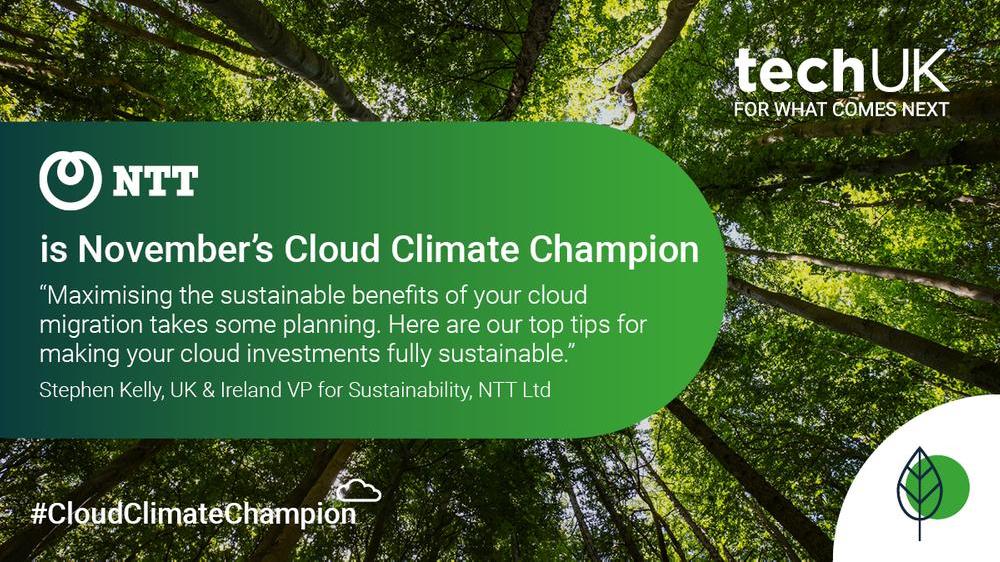Using the cloud to drive sustainability goals (Guest blog from NTT Ltd)

Author: Stephen Kelly, UK & Ireland VP for Sustainability, NTT Ltd
Digital transformation puts IT leaders in a unique position to nudge their businesses towards sustainable operations. For any organisation going digital, cloud computing has become the centrepiece IT architecture. That creates significant opportunities to decarbonise.
Instead of expensive, power-hungry, on-premises data centres, businesses use only as much storage and computing capacity as activity levels demand. The need to own and maintain physical hardware disappears, along with the need to power racks of heavy hardware, or arrange disposal when appliances reach their end-of-life.
But beyond obvious benefits like energy cost savings, how sustainable is the cloud? Are there other ways to leverage a cloud migration for environmental benefit, and if so, how do we measure the sustainable impact and contribution to ESG goals?
Why is the cloud more sustainable?
Trading your on-premises infrastructure for the cloud means you treat information technology as a service. The business benefits are well-known: less overhead, increased scalability, and the option to turn capital spend into operational spend. It's also much better for the environment, as your IT infrastructure is using less power and contributing less embodied carbon.
Cloud data centres are also more efficient than their smaller, on-premises cousins. They operate at hyperscale and use techniques like dynamic provisioning to ensure customers consume exactly as much computing and storage capacity as they need at any given time — but not more.
A modern cloud data centre is also designed to reduce power consumption and generate less heat, which in turn requires less cooling. The major public cloud providers have also been leaders in moving to renewables, so most of their data centres are powered by green sources like wind, hydro, and solar.
All these benefits can contribute directly to core ESG commitments like achieving sustainable operations and moving to 100% renewable energy.
But maximising the sustainable benefits of your cloud migration takes some planning. Here are our top tips for making your cloud investments fully sustainable.
Making your cloud migration green
1 - Consider moving to a public cloud
- The primary public cloud providers — Microsoft Azure, Amazon Web Services, and Google Cloud Platform — have built carbon neutral infrastructure and delivery models. Depending on the services used, their data centres can be 50-70 per cent more energy efficient than traditional on–premises data centres.
2 - Use cloud-native applications
- Compared to traditional enterprise applications, cloud-native apps are containerized, which means they only use the minimum information required to execute a given operation. That means they require significantly fewer computing resources and as such, draw less electricity in order to run. You can find out more about how to reduce the software emissions your business is responsible for, at the Green Software Foundation.
3 - Only use the cloud resources you really need
- Because cloud environments can be activated and configured remotely, they can also be forgotten about or left to lie unused. That leads to invoices for services that aren't being utilised. It’s a good idea to create automated ‘sunset’ rules to delete any non-vital resources lying dormant for extended periods of time. You should also look at metrics like server refresh rates to see where new efficiencies might be found.
4 - Talk to your supplier
- As demand for sustainability grows, cloud service suppliers are getting very good at capturing data around their carbon impact, energy consumption, and so on. Ask about their green reporting capabilities so you can understand how their services are contributing to your ESG objectives.
5 - Recycle your devices
- As you move to the cloud, pay careful attention to the technology you remove. It is critical that the technology sector drives innovation in this space. Mining minerals from e-waste will contribute significantly to creating a meaningful circularity.
techUK – Committed to Climate Action
By 2030, digital technology can cut global emissions by 15%. Cloud computing, 5G, AI and IoT have the potential to support dramatic reductions in carbon emissions in sectors such as transport, agriculture, and manufacturing. techUK is working to foster the right policy framework and leadership so we can all play our part. For more information on how techUK can support you, please visit our Climate Action Hub and click ‘contact us’.







